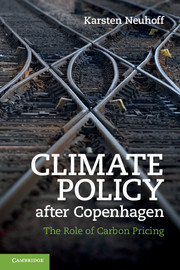Book contents
- Frontmatter
- Contents
- List of figures
- List of tables
- List of boxes
- Acknowledgements
- List of abbreviations
- 1 Introduction
- 2 The role of a climate policy mix
- 3 Implementing a carbon price: the example of cap and trade
- 4 Shifting investment to low-carbon choices
- 5 Co-operation among developed countries: a role for carbon markets?
- 6 A world of different carbon prices
- 7 International support for low-carbon growth in developing countries
- 8 Conclusion
- References
- Index
5 - Co-operation among developed countries: a role for carbon markets?
Published online by Cambridge University Press: 05 June 2012
- Frontmatter
- Contents
- List of figures
- List of tables
- List of boxes
- Acknowledgements
- List of abbreviations
- 1 Introduction
- 2 The role of a climate policy mix
- 3 Implementing a carbon price: the example of cap and trade
- 4 Shifting investment to low-carbon choices
- 5 Co-operation among developed countries: a role for carbon markets?
- 6 A world of different carbon prices
- 7 International support for low-carbon growth in developing countries
- 8 Conclusion
- References
- Index
Summary
Limiting growth in global average temperatures to 2 °C above historic levels can only be achieved if greenhouse gas emissions are drastically reduced across all major emitting countries. It requires joint action across developed and, as discussed in Chapter 7, developing countries.
The need for joint action frequently prompts the question whether countries can and should pursue climate policy prior to an international agreement, or beyond the level of ambition thus agreed. Section 5.1 explores how international co-operation can enhance the level of national ambition by creating a sense of responsibility for own emissions and building trust and a sense of joint effort. Thus, international co-operation can encourage and support first movers and serve as a commitment device to facilitate effective policy implementation.
International co-operation can provide early and tangible results by encouraging and supporting transparent monitoring and reporting (section 5.2). With better information, governments can implement policies and programmes more effectively. It also facilitates rapid international learning on policy success and failure on how to achieve low-carbon development.
Of particular interest is the global carbon market. Section 5.3 outlines the design options, including a description and evaluation of trading at government or installation levels and the design options for such trading. Linking national carbon markets is usually described and analysed from the perspective of static efficiency gains. However, with increasing focus on low-carbon development, the incentives this can create for innovation and diffusion of low-carbon technology and infrastructure need to be considered (section 5.4).
- Type
- Chapter
- Information
- Climate Policy after CopenhagenThe Role of Carbon Pricing, pp. 132 - 161Publisher: Cambridge University PressPrint publication year: 2011

